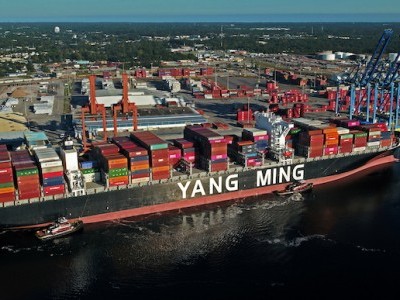The St. Lawrence Seaway System: U.S. farmers’ key advantage for competing globally
American ports in the Great Lakes-St. Lawrence Seaway System traded with a total of 32 countries in August. Shipments of commodities including wind energy components and gypsum remained strong, while exports of agricultural products picked up pace. Year-to-date total tonnage—from the opening of the St. Lawrence Seaway on April 1, 2020 through August 31, 2020—increased to 19.3 million metric tons (mt), but overall tonnage is down 8.4 percent compared to this time last year.
Craig H. Middlebrook, Deputy Administrator of the U.S. Saint Lawrence Seaway Development Corporation said, “Exports of U.S. agricultural products were the stand-out commodity moving through the Seaway in August. Grain products shipped over the Seaway are used to produce everything from bread, pasta, soymilk, and vegetable oil to beer, ethanol, and animal feed. Shipping through the Seaway helps our U.S. farmers compete effectively in a global market.”
Top-performing commodities through August 2020
- Commodity Metric Tons Handled Growth*
- Grain** 5,947,000 mt 13.3 percent increase**
- Gypsum 460,000 mt 69.4 percent increase*
- Steel Slab 245,000 mt 146.8 percent increase*
- Liquid Chemicals 323,000 mt 1.2 percent increase*
- Dry Chemicals 134,000 mt 0.1 percent increase*
*Percentages rounded to nearest tenth (compared year-over-year)
**Combined U.S. and Canadian
Feeding the world: Exports of agricultural products pick up pace for American ports
As global demand for soybean continues growing this year, American ports in the Great Lakes-St. Lawrence Seaway System saw an increase in exports of agricultural products. Ports, like the Port of Toledo, Port of Duluth-Superior and Port of Indiana-Burns Harbor led the charge, exporting a total of nine shipments of wheat and soybeans.
In July, the Port of Toledo’s tonnage lagged behind 2019 totals by 15 percent. After August, that gap was narrowed to just 8 percent as the port surpassed the 5-million-ton mark for the year. During the month, the port welcomed a number of Seaway vessels to Toledo, importing and exporting a diverse array of cargo from furnace pieces to liquid fertilizer.
“One vessel imported pig iron and then sailed seven miles up the Maumee River to load soybeans,” said Joseph Cappel, VP of Business Development for the Toledo-Lucas County Port Authority. “I believe the grain terminals are poised for a good fall program, and anytime we can reload vessels that are already here discharging cargo, it is a logistical homerun.”
Handling several agricultural exports in August, the Port of Duluth-Superior’s 2020 grain tonnage is 14.5 percent ahead of the 2019 pace and 7 percent ahead of the five-season average. As another addition to the Seaway-wide export activity, the Port of Indiana-Burns Harbor moved a shipment of soybeans.
In total, these three ports moving agricultural products through the Great Lakes-St. Lawrence Seaway System handled outbound wheat and soybeans to four countries — Egypt, Italy, Belgium, and the United Kingdom.
Similar Stories

Stena RoRo takes delivery of the battery hybrid vessel Guillaume de Normandie
View Article
Indian Register of Shipping reflects on 2024 and sets ambitious goals for 2025
View Article
Yang Ming announces 2025 Trans-Atlantic services
View Article
Exclusive interview with AWO’s Jennifer Carpenter
View ArticleMSC GRI - scope: USA to Bahamas
MSC Mediterranean Shipping Company Co. (USA) Inc has filled and will implement a GRI with below quantum, scope, and effective date for all DRY and Reefer containers as follows:
View ArticleMSC GRI - scope: ISC/ME - Import Indian Subcontinent/Middle East to USA
Mediterranean Shipping Company has filed and will implement the following GRI - General Rate Increase effective January 20th, 2025, as below.
View ArticleGet the most up-to-date trending news!
SubscribeIndustry updates and weekly newsletter direct to your inbox!





